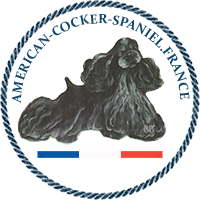An eye for a dog
UNE MEILLEURE APPROCHE DU CHIEN
AVOIR L’ŒIL POUR LE CHIEN
Par Claudia Waller Orlandi, Ph.D.

L’éventail de qualité recherché́ chez les chiens dans n'importe quelle race révèle que tout le monde n'est pas né́ pour être éleveur. Les experts estiment que l'un des signes du potentiel d'un éleveur pour produire des animaux de haute qualité est de savoir s'il possède un «œil pour un chien».
Grossman (1983) nous dit :
« L'importance d'avoir un œil pour un chien né peut pas être surestimée … Il existe des éleveurs extrêmement compétents qui peuvent «parler chien», et né sont pas en mesure de produire un spécimen exceptionnel… Produire régulièrement des chiens de qualité devrait être considéré comme un art. Pour certains éleveurs, cela vient naturellement, avec peu d'effort ; d'autres doivent apprendre cet art ; et d'autres encore né réussiront jamais dans le domaine de l’élevage de chiens de race. »
QUE VEUT DIRE « ŒIL POUR UN CHIEN » ?
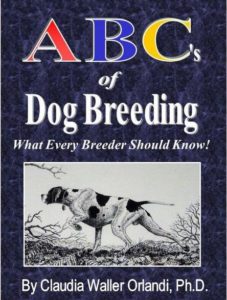
Un « œil pour un chien » est une ancienne expression qui se réfère à la « capacité presque instinctive de la personne à reconnaître les vraies qualités et les défauts chez les animaux » (Nicholas, 1979). Grossman (1992) définit le terme comme « la capacité de choisir un bon chien sans beaucoup d’efforts » et conclut que cet attribut, plus que tout autre, est la chose la plus importante qu'un éleveur peut posséder. En plus d'avoir une plus grande capacité à visualiser l'impact potentiel de divers ancêtres dans le pédigrée d'un chien, les éleveurs avec un « œil » ont tendance à saisir plus facilement des concepts de reproduction abstraits tels que l'équilibre.
L'analogie suivante de Grossman (1991), qui se réfère à des chiens à poils longs, offre une explication intelligente d'un « œil pour un chien » : je suis certain que tous apprécieront !
« Qu'est-ce que je veux dire par avoir un œil pour un chien ? Permettez-moi de faire une analyse pour vous. Lorsque ma femme fait du shopping, elle passé à travers de nombreux rayons de robes. Pour moi, elles ressemblent à du tissu sur des cintres. Elle connaît les tailles, les couleurs et le style qui lui vont, il est facile pour elle de visualiser les accessoires né́cessaires pour parfaire sa tenue.
Vous, en tant que sélectionneur, devez faire le même genre de recherches : quel type de construction voulez-vous pour vos chiots, quelle devrait être leur couleur, quels critères, texture et longueur de la robe, implantation d'oreille, etc. voulez-vous ? Vous devez pouvoir visualiser le père et la mère ainsi que leurs parents et grands-parents. Ensuite, vous pouvez produire par mariages presque comme ceux que vous avez visualisés. »
CARACTERISTIQUES DES PERSONNES QUI ONT UN « ŒIL POUR UN CHIEN »
1. En tant que sélectionneurs, ils produisent constamment des animaux de haute qualité.
2. Ils peuvent évaluer n'importe quel chien rapidement et facilement.
3. Ils ont une capacité instinctive à reconnaître la qualité et la solidité dans presque toutes les races. 4. Ils accordent une priorité élevée et savent reconnaître l'élément intangible : la balance — l’équilibre.
ACQUERIR UN « ŒIL POUR LE CHIEN » : UN MENTOR PEUT AIDER
Pour certains éleveurs, « avoir un œil pour un chien » est une seconde nature. Les éleveurs qui manquent de ce talent naturel peuvent devenir autodidactes à condition qu'ils aient l'intelligence et la motivation né́cessaires pour discerner les spécimens bons et mauvais qui leur sont soumis. (Grossman, 1983)
Les éleveurs qui produisent constamment de bons chiens peuvent avoir un œil naturel pour un chien, tandis que d'autres personnes persistantes et dévouées à une race se sont documentées pour acquérir un œil pour le chien. L'artiste a l'œil pour l'équilibre et l'élégance. Il devrait en être de même pour le sélectionneur. Pour ceux qui ont besoin d'entraîner leur « œil », travailler avec un mentor confirmé peut vous mettre sur la voie rapidement pour acquérir cet « œil ».
Un mentor expérimenté peut littéralement placer vos mains sur diverses parties de l'anatomie d'un chien et vous guider par de nombreux aspects de l'évaluation physique d'un chien.
ENTRAINER VOTRE « ŒIL »
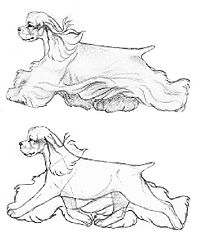 Les éleveurs peuvent commencer à former leur « œil » en apprenant à évaluer l'apparence extérieure ou le phénotype d'un chien. Plusieurs éléments utiles pour évaluer le phénotype :
Les éleveurs peuvent commencer à former leur « œil » en apprenant à évaluer l'apparence extérieure ou le phénotype d'un chien. Plusieurs éléments utiles pour évaluer le phénotype :
1. une copie du standard officiel et illustré de votre race ;
2. A list of faults in your breed that are considered Very Serious, Serious and Minor;
3. une illustration des parties anatomiques du chien ;
4. un système de notation ;
5. un système de sauvegarde qui vous permet de conserver vos évaluations pour une utilisation future.
Le processus de formation de votre « œil » pour évaluer les caractéristiques de conformation d'un chien implique les étapes suivantes :
1. Localisation des parties du chien
La connaissance des parties du corps de base d'un chien est une né́cessité absolue pour tout amateur. Étudiez votre standard et ses illustrations et, à l'aide d'un tableau anatomique, localisez sur un chien « vivant – modèle » chaque caractéristique de conformation. L’étude de chaque partie de votre chien est essentielle pour décider si elle correspond au standard — cela constitue une étape déterminante dans la formation de votre « œil ».
2. Évaluation des parties du chien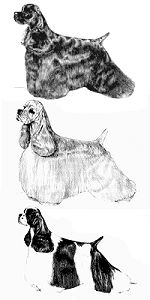 Après avoir localisé les parties du chien, l'éleveur doit évaluer leur conformité au standard. Comme le note Grossman (1983) : « Le fait de relier les différentes parties du chien les unes aux autres et de voir cette relation dans son ensemble, plutôt que comme une série de caractéristiques individuelles bonnes ou mauvaises, est la clé que tant d'éleveurs né saisissent jamais » — C'est la notion cruciale d'équilibre. La formation de votre « œil » pour évaluer l'équilibre né́cessite une persistance et une expérience.
Après avoir localisé les parties du chien, l'éleveur doit évaluer leur conformité au standard. Comme le note Grossman (1983) : « Le fait de relier les différentes parties du chien les unes aux autres et de voir cette relation dans son ensemble, plutôt que comme une série de caractéristiques individuelles bonnes ou mauvaises, est la clé que tant d'éleveurs né saisissent jamais » — C'est la notion cruciale d'équilibre. La formation de votre « œil » pour évaluer l'équilibre né́cessite une persistance et une expérience.
3. Annoter vos évaluations
Notez vos évaluations pour référence ultérieure. De nombreux maîtres éleveurs élaborent des systèmes de notation numériques qui sont rapides et faciles à utiliser lors de la planification des mariages futurs.
4. Établir un plan d’élevage
Sur la base de vos notes et observations, établissez un plan pour améliorer les caractéristiques qui né répondent pas au standard. La notation et la prise d’observations sur les trois premières géné́rations d'ancêtres dans un pédigrée peuvent aider un éleveur à « visualiser » ce qu’un futur accouplement pourrait produire. La capacité de visualiser les ancêtres derrière un père et une mère fait partie intégrante d'un « œil » pour un chien. Un code couleur peut être particulièrement utile à cet égard. Il est important de né pas marier deux chiens qui possèdent les mêmes fautes et de réaliser que des animaux en étroite consanguinité (c.-à-d. ceux qui ont un ancêtre commun derrière le père et la mère dans les trois premières géné́rations) peuvent être plus à même de transmettre leurs caractéristiques physiques à leur progéniture.
UN « ŒIL » POUR L'IDEAL
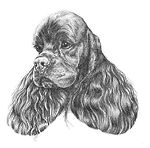 Un point de départ dans le renforcement de l’«œil» d'un éleveur est la capacité à déterminer et évaluer les caractéristiques de conformation, les caractéristiques individuelles et l'équilibre structurel qui définissent une race. Avoir l'œil pour visualiser les ancêtres d'un père et de la mère, combiné à l'utilisation de systèmes de notation et de références, peut fournir des informations précieuses sur les traits que les parents sont susceptibles de transmettre à leur progéniture.
Un point de départ dans le renforcement de l’«œil» d'un éleveur est la capacité à déterminer et évaluer les caractéristiques de conformation, les caractéristiques individuelles et l'équilibre structurel qui définissent une race. Avoir l'œil pour visualiser les ancêtres d'un père et de la mère, combiné à l'utilisation de systèmes de notation et de références, peut fournir des informations précieuses sur les traits que les parents sont susceptibles de transmettre à leur progéniture.
Le but d'un éleveur est de créer son chien idéal. Avoir un « œil », c'est‑à-dire avoir la capacité de reconnaître les qualités chez un chien, ainsi que la capacité de visualiser les ancêtres dans un pédigrée, sont les critères les plus importants qu'un éleveur doit posséder pour créer son idéal.
REFERENCE:
- Battaglia, C. L. 1986. Breeding Better Dogs. Atlanta, GA, BEI Publishing – ISBN-10 : 0932419062
- Grossman, A. 1983. The Standard Book of Dog Breeding. Fairfax, VA, Denlinger – ASIN : B019TLUZGY
- Grossman, A. et B. 1992. Winning With Purebred Dogs. Wilsonville, OR, Doral. – ASIN : B009NNYFYM
